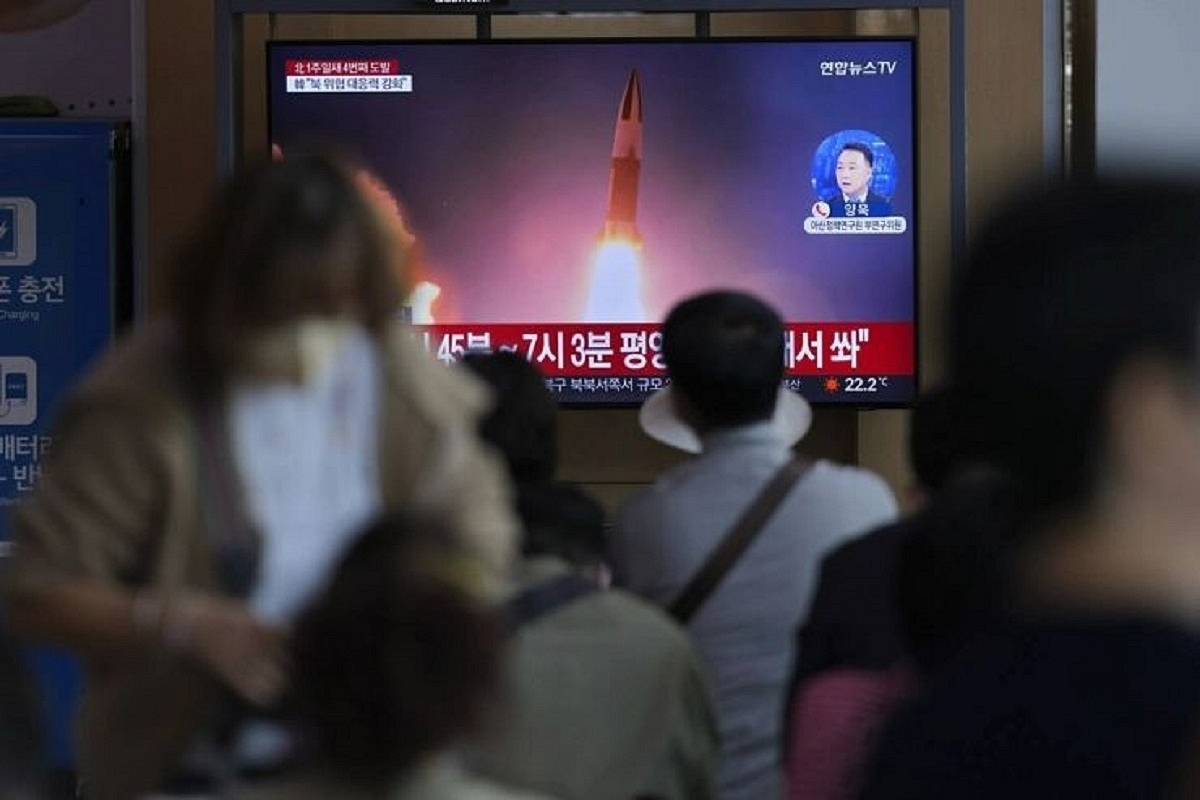World
Explained: North Korea's Recent Missile Launches
- The latest missile touched an altitude of 603 miles and flew around 2,800 miles, as per Japanese and South Korean assessments.

A news programme reports on North Korea’s missile launch with file imagery at the Seoul Railway Station in Seoul, South Korea.
Today (4 October), Japan witnessed a North Korean missile fly over its territory for the first time since 2017.
Back in 2017, it seemed that the US and North Korea were edging towards conflict.
This is the time when North Korea, after firing a missile over Japan, threatened to fire four intermediate range ballistic missiles into the water around the US base in Guam.
Donald Trump, who was the president of US at that time, vowed to unleash 'fire and fury'. What followed was intense diplomatic outreach through backdoor channels.
Today's launch is a significant escalation.
According to South Korean military, a single intermediate-range missile was launched at 7.23 am local time from the North’s Chagang Province, bordering China.
"Although North Korea has developed and tested increasingly powerful ballistic missiles in recent years, it has rarely fired them over Japan, an act considered extremely provocative by both Tokyo and Washington," reads a report in the US.
The missile touched an altitude of 603 miles and flew around 2,800 miles, as per Japanese and South Korean assessments.
The Japanese government had to issue an emergency warning for people living in the projected path. People had to take cover as the missile flew past northern Japan, into the Pacific Ocean.
Over the last few weeks, North Korea has tested a number of short-range weapons but this launch was the longest-range launch since the testing of an intercontinental ballistic missile back in May.
"This is an outrageous act following the recent repeated launches of ballistic missiles and we strongly denounce it," said Japanese Prime Minister Fumio Kishida.
South Korea's national security council sat for an emergency meeting and called the launch a serious provocation that threatened peace in the region.
The missile test didn't pose any threat to the US personnel or territory, said the US Indo-Pacific command, while condemning the missile launch and urging North Korea to refrain from "further unlawful and destabilizing acts”.
The last time North Korea launched an intermediate range ballistic missile was in January.
The potential range of these weapons does not pose a risk to the US mainland but they do have the capability of reaching American military bases in Guam around 2,000 miles from North Korea.
Unlike this launch, the January launch of the Hwasong-12 missile didn't fly over Japan.
It took a lofty trajectory and landed between the sea of Korea and Japan.
Today's launch travelled at about half the altitude of the January test, though it travelled about five times farther in distance.
North Korea has conducted more missile tests in 2022 than in any other year.
This year, North Korea has already conducted more than 20 missile tests.
These tests include intermediate-range and intercontinental ballistic missiles. Estimates suggest that the latter is capable of striking the US mainland.
As people in Japan started their day today, people in three Japanese prefectures received emergency warning on their cell phones stating — "Missile launch. Please take shelter in a building or underground".
The Chagang province has been the launchpad for missile tests earlier as well.
In 2017, North Korea launched an ICBM (inter-continental ballistic missile) from this province.
As per a report by the Center for Strategic and International Studies, Chagang province is home to a secret missile base which houses long-range ballistic missiles.
Today's launch was North Korea's fifth missile test in 10 days. These tests come amidst US Vice President's visit to the region.
Reports suggest that the US, Japan and South Korea were also conducting tri-lateral anti-submarine exercises at the time when Pyongyang was testing its missiles.
South Korean intelligence believes that Pyongyang is planning its first nuclear test since 2017.
The test might come in the time period between China's National Congress and America's mid-term elections.
It is worth highlighting that as of just a month back, North Korea has declared that its nuclear status is irreversible. It has rejected denuclearisation talks with South Korea and the US.
The parliament in Pyongyang has passed a new law which permits pre-emptive strikes if the North Korean leadership comes under attack.
Introducing ElectionsHQ + 50 Ground Reports Project
The 2024 elections might seem easy to guess, but there are some important questions that shouldn't be missed.
Do freebies still sway voters? Do people prioritise infrastructure when voting? How will Punjab vote?
The answers to these questions provide great insights into where we, as a country, are headed in the years to come.
Swarajya is starting a project with an aim to do 50 solid ground stories and a smart commentary service on WhatsApp, a one-of-a-kind. We'd love your support during this election season.
Click below to contribute.
Latest